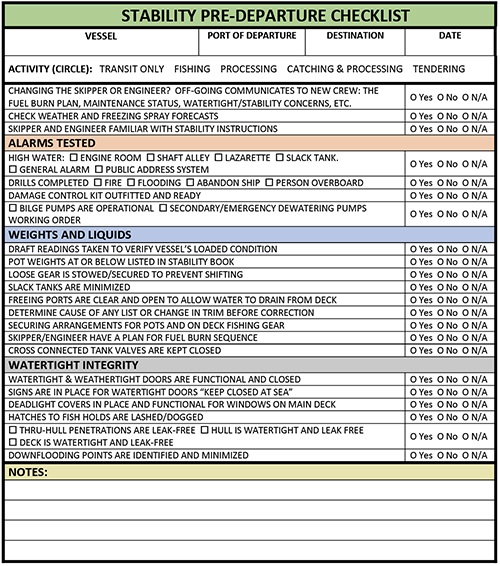 Continuing our series on fishing vessel stability, this month’s article focuses on operational stability and offers some tools to help the folks on board keep things ‘Upright and Watertight.’
Continuing our series on fishing vessel stability, this month’s article focuses on operational stability and offers some tools to help the folks on board keep things ‘Upright and Watertight.’
In the previous two articles we covered the importance of stability training: fishing vessel-specific-training, and which vessels and at what thresholds do stability regulations apply. Now, you put your vessel to use.
The decisions made by the skipper, engineer and crew, combined with the physical forces of nature, make for a complex and dynamic scene that if allowed to get out of hand, can cause catastrophe. Here are some ways to mitigate the risks while at sea.
Maintain Watertightness
Keep doors and hatches always secured except while using them. If the manually operated six-dog door is too much of a pain to dog each time you go through it and the crew ends up tying it open, then install a quick-acting door. On these doors, with the turn of one lever all the dogs operate together. Much easier to close and dog after passing through.
Pay particular attention to openings on the exposed weather deck and superstructure. All openings should be able to be made water or weathertight. This includes doors, hatches, vents, access ports, etc. Check gaskets and seals. Operate the dogs and handles.
Proper Loading: Keep Weight Low and Centered
By knowing the location of your vessel’s vertical center of gravity (VCG), you will know that if you add a weight below this point, you are lowering your overall center of gravity. If you load something above it, then you are raising it. The same goes for the longitudinal center of gravity (LCG). Loading or moving a weight forward or aft of this point will change your vessel’s trim that can adversely affect your vessel’s righting energy.
Weather and Icing Conditions
Many seasoned fishermen are aware of how dangerous ice accumulation is on a vessel. The calculations in your stability book use a maximum of 1.3 inches of ice on horizontal surfaces and .65 inches on vertical surfaces, all accumulated symmetrically.
In reality, ice often accumulates on one side or concentrates in one area and ice can accumulate inside pots. Despite the freezing spray weather forecasts, many areas of Alaska have microclimates where local conditions can cause heavy ice accumulations that might not be included in general forecast messages. Avoid areas of freezing spray, take notice of weather forecasts and get the crew knocking off the ice immediately.
Free Surface
Liquids in tanks or the sloshing fish in the hold can cause a vessel to lose stability and capsize. If your fish hold is routinely flooded, ensure you have slack tank alarms, and minimize the number of slack fuel and water tanks.
A National Transportation Safety Board (NTSB) report on the loss of the Emmy Rose—a fishing vessel that sank off New England, resulting in the loss of all four fishermen—suggested that poor fuel tank management may have led to the 82-foot trawler listing severely to one side. Combined with a quartering sea, water was allowed to ship on deck and down flood into the lazarette.
How Else Can You Be Prepared?
You have your stability instructions from the naval architect, you took a training course and now you’re ready to go fishing. Keep your vessel’s stability top of mind by using a pre-departure checklist. AMSEA has developed a stability pre-departure checklist with a list of items that should be verified before each trip. The checklist, which can be seen on the next page, is also downloadable at amsea.org..
When it comes to stability, remember, it usually isn’t just one thing that will cause a vessel loss; it is often incremental, slow, and little changes that happen over time that lull you into thinking everything is just fine. Then it gets to a point where the boat can’t take it anymore and is lost.
So arm yourself to the best of your ability with all available information, resources and tools. Come home safely!
Mike Rudolph has been a safety professional and trainer with the U. S. Coast Guard spanning over three decades, covering commercial fishing safety from Dutch Harbor, Alaska to Brookings, Oregon and beyond. He is an AMSEA-certified Drill Instructor and Fishing Vessel Stability Trainer based in Portland, Oregon. His passion is to help fishermen reduce the risks involved in their occupation so they can return to their families—or people that owe them money—after every trip.
